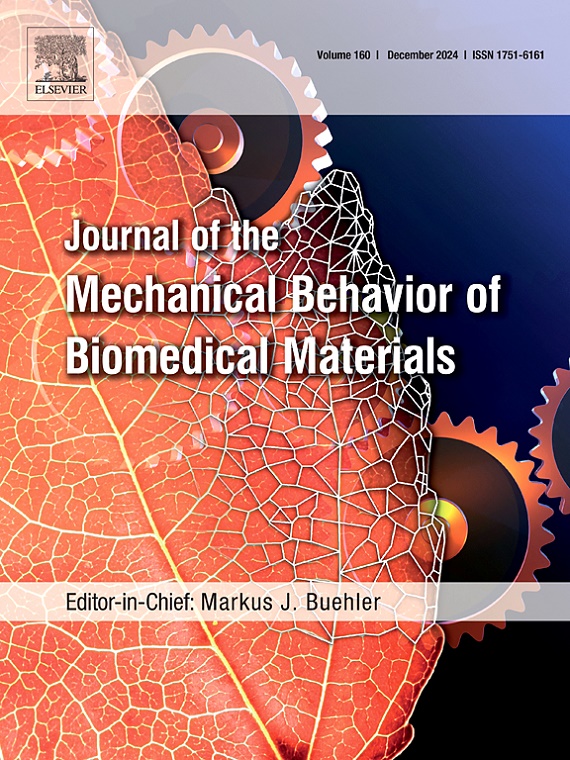A bio-lattice deep learning framework for modeling discrete biological materials
IF 3.3
2区 医学
Q2 ENGINEERING, BIOMEDICAL
Journal of the Mechanical Behavior of Biomedical Materials
Pub Date : 2025-01-25
DOI:10.1016/j.jmbbm.2025.106900
引用次数: 0
Abstract
Biological tissues dynamically adapt their mechanical properties at the microscale in response to stimuli, often governed by discrete interacting mechanisms that dictate the material’s behavior at the macroscopic scale. An approach to model the discrete nature of these elemental units is the Lattice Spring Modeling (LSM). However, the interactions in biological matter can present a high degree of complexity and heterogeneity at the macroscale, posing a computational challenge in multiscale modeling. In this work, we propose a novel machine learning-based multiscale framework that integrates deep neural networks (DNNs), the finite element method (FEM), and a LSM-inspired microstructure description to investigate the behavior of discrete, spatially heterogeneous materials. We develop a versatile, assumption-free lattice framework for interacting discrete units, and derive a consistent multiscale connection with our FEM implementation. A single DNN is trained to learn the constitutive equations of various particle configurations and boundary conditions, enabling rapid response predictions of heterogeneous biological tissues. We demonstrate the effectiveness of our approach with extensive testing, starting with benchmark cases and progressively increasing the complexity of the microstructures. We explored materials ranging from soft to hard inclusions, then combined them to form a macroscopically homogeneous material, a gradient-varying polycrystalline solid, and fully randomized configurations. Our results show that the model accurately captures the material response across these spatially varying structures.
用于离散生物材料建模的生物晶格深度学习框架。
生物组织在微观尺度上动态调整其力学特性以响应刺激,通常由离散的相互作用机制控制,这些机制决定了材料在宏观尺度上的行为。对这些基本单元的离散性进行建模的一种方法是晶格弹簧建模(LSM)。然而,生物物质中的相互作用在宏观尺度上具有高度的复杂性和异质性,这给多尺度建模带来了计算挑战。在这项工作中,我们提出了一种新的基于机器学习的多尺度框架,该框架集成了深度神经网络(dnn)、有限元方法(FEM)和lsm启发的微观结构描述,以研究离散的、空间非均质材料的行为。我们为相互作用的离散单元开发了一个通用的,无假设的晶格框架,并推导出与我们的FEM实现一致的多尺度连接。训练单个DNN来学习各种粒子构型和边界条件的本构方程,从而实现对异质生物组织的快速响应预测。我们通过广泛的测试证明了我们方法的有效性,从基准案例开始,逐步增加微观结构的复杂性。我们探索了从软到硬的夹杂物,然后将它们结合起来形成宏观上均匀的材料、梯度变化的多晶固体和完全随机的结构。我们的结果表明,该模型准确地捕获了这些空间变化结构中的材料响应。
本文章由计算机程序翻译,如有差异,请以英文原文为准。
求助全文
约1分钟内获得全文
求助全文
来源期刊

Journal of the Mechanical Behavior of Biomedical Materials
工程技术-材料科学:生物材料
CiteScore
7.20
自引率
7.70%
发文量
505
审稿时长
46 days
期刊介绍:
The Journal of the Mechanical Behavior of Biomedical Materials is concerned with the mechanical deformation, damage and failure under applied forces, of biological material (at the tissue, cellular and molecular levels) and of biomaterials, i.e. those materials which are designed to mimic or replace biological materials.
The primary focus of the journal is the synthesis of materials science, biology, and medical and dental science. Reports of fundamental scientific investigations are welcome, as are articles concerned with the practical application of materials in medical devices. Both experimental and theoretical work is of interest; theoretical papers will normally include comparison of predictions with experimental data, though we recognize that this may not always be appropriate. The journal also publishes technical notes concerned with emerging experimental or theoretical techniques, letters to the editor and, by invitation, review articles and papers describing existing techniques for the benefit of an interdisciplinary readership.
 求助内容:
求助内容: 应助结果提醒方式:
应助结果提醒方式:


